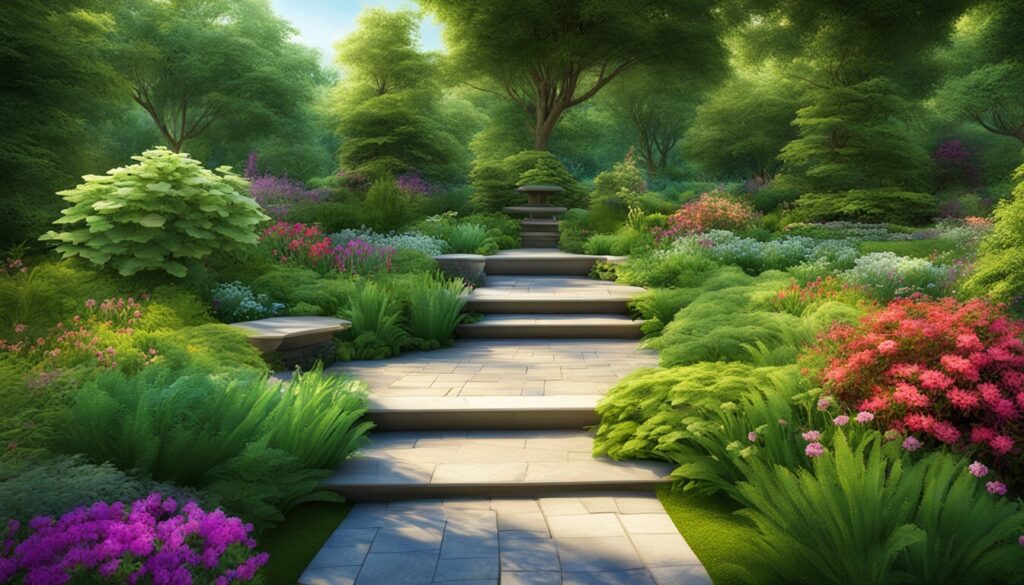Every time I step into my garden, it feels like I’m saying hello to old friends. The perennial plants are the stars of the show, always ready to bloom. They range from the lush evergreen blooms to the tall yarrow, reaching up to 75cm high and 60cm wide1. My garden is a living masterpiece, filled with garden flowers that come back year after year.
Plants like Michaelmas daisies and elephant’s ears add beauty to my garden. The daisies stand tall at 75cm, while the elephant’s ears spread out 45cm in all directions1. These plants are more than just decorations; they’re a celebration of life. They let me enjoy the vibrant dahlias and the stunning peonies, which come back year after year2.
I encourage you to explore rain garden plants for your garden. They’re not just beautiful; they help with sustainable gardening. Imagine a garden that’s a home for wildlife and manages stormwater, full of life and purpose.
Key Takeaways
- Perennial garden flowers offer a reliable beauty that evolves with the seasons.
- Opting for varieties like yarrow and Michaelmas daisies can provide structure and visual appeal1.
- Peonies and dahlias invite a legacy of continuous growth and diverse floral architecture into the garden2.
- Rain gardens are an eco-friendly addition that blend functionality and environmental care1.
- Creating a haven for winged wildlife enriches both the biodiversity and the spirit of a garden.
Embracing Evergreen Beauty in Your Garden
I love gardening and have found that evergreen perennials are key to keeping my garden looking great all year. Plants like hellebores and viburnums not only provide a steady green background. They also add color with their blooms at different times of the year. For example, hellebores bloom from late winter to early spring in zones 4-9, showing off colors from pink to deep purple3.
Adding evergreens to your garden is more than just planting. It’s about creating a beautiful scene that looks good all year. Camellias, which do well in zones 6-10, have shiny green leaves and bloom in winter. They bring color when most plants are asleep3. Putting them in your garden makes it look better and keeps it interesting in the cold months.
For evergreens to do well, you need to mulch them. A 5 cm layer of organic stuff like leaves or pine needles helps keep the roots warm and the soil moist3. This is a key step to keep your evergreens looking lush all year.
- Daphne shrubs bloom in late winter with a sweet smell and are good for zones 7-9.
- Viburnums start blooming late winter, adding beauty all year.
- Japanese maples, though sensitive to cold, can be covered with frost cloths to help them survive winter.
Evergreens make seasonal changes beautiful, not bare. They turn your garden into a masterpiece that changes but always stays green. This is why evergreens are so important in garden design— they make every season special.
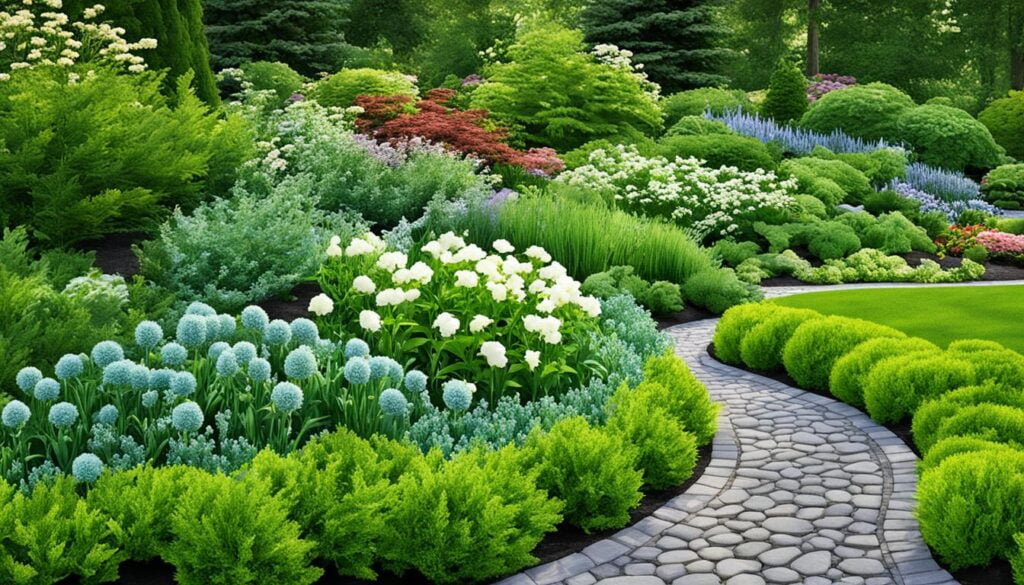
Cherishing the Resilience of Lenten Rose
The Lenten Rose, also known as Hellebores, is a symbol of beauty in winter gardens. These plants bloom when most gardens are asleep. They add beauty and help the environment.
Lush Evergreen Foliage as a Year-Round Accent
Hellebores keep their green leaves all year, making a beautiful background in winter. They love rich soil and can grow in many gardens4. These plants grow 9 to 18 inches tall and spread 12 to 24 inches wide, perfect for shady spots4.
Welcoming Winter Blooms: Lenten Rose’s Seasonal Showcase
Hellebores are famous for their winter blooms. They can have up to 50 flowers each, brightening your garden from late winter to early spring4. These flowers help bees when there’s little food around5.
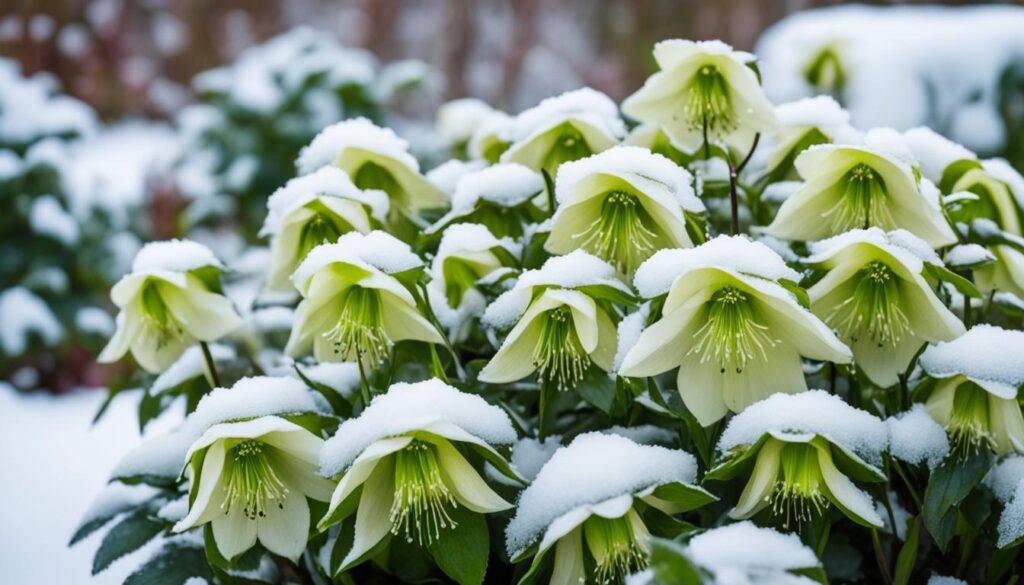
| Variety | Color Range | Blooming Period | USDA Zone |
|---|---|---|---|
| Winter Dreams | White to Pink | Late Winter | 3 – 9 |
| Snowbells | White | Early Spring | 3 – 7 |
| Christmas Rose | White | Mid Winter | 3 – 8 |
Traditional Hellebores like ‘Winter Dreams’ and ‘Snowbells’ grow in zones 3 to 9 and 3 to 7, showing they can adapt to different climates4. These plants symbolize hope and resilience, making them a key part of winter garden stories5.
Adding Lenten Rose to your garden makes it more beautiful and full of hope. These winter flowers show the strength and beauty of nature.
Peonies: The Perennial Garden’s Showstopper
Peonies are a favorite in any garden, known for their stunning looks and toughness. They grow well in Zones 3 to 8, perfect for the Midwest’s climate6. These plants can handle cold winters and hot summers.
To make sure peonies grow well, plant them 2 to 3 feet apart6. Make sure the roots sit level with the soil. Once they’re set, their deep roots mean they rarely need moving and can stay in one spot for years6.
Peonies embody the essence of fragrant flowers; their aromatic blooms enrich any garden atmosphere.

Peonies come in many types, each with its own charm. The Bartzella Itoh Peony has big, lemon-yellow flowers that spread joy7. The Coral Charm Peony changes from coral to soft peach as it blooms, adding beauty to any garden7.
Unveiling the Aromatic Charms of Peony Flowers
Peonies are famous for their scent. The Kansas Peony has soft, fragrant petals7. The Red Charm Peony’s deep red flowers are up to 8 inches wide, standing out against their leaves7.
Looking after these flowers is easy. Feed them once a year in spring for the best blooms6. After they stop blooming, cut them back to the ground after the first frost6. This keeps them healthy and ready for spring.
Learning about peonies adds to the fun and beauty of gardening. They are key to a garden’s long-term beauty and fragrance.
Penstemon: The Pollinator’s Perennial Paradise
Penstemon, also known as beardtongue, is more than just a pretty face in gardens. These plants are key to supporting our ecosystems with their unique tube-shaped flowers. They attract pollinators and add beauty to gardens.
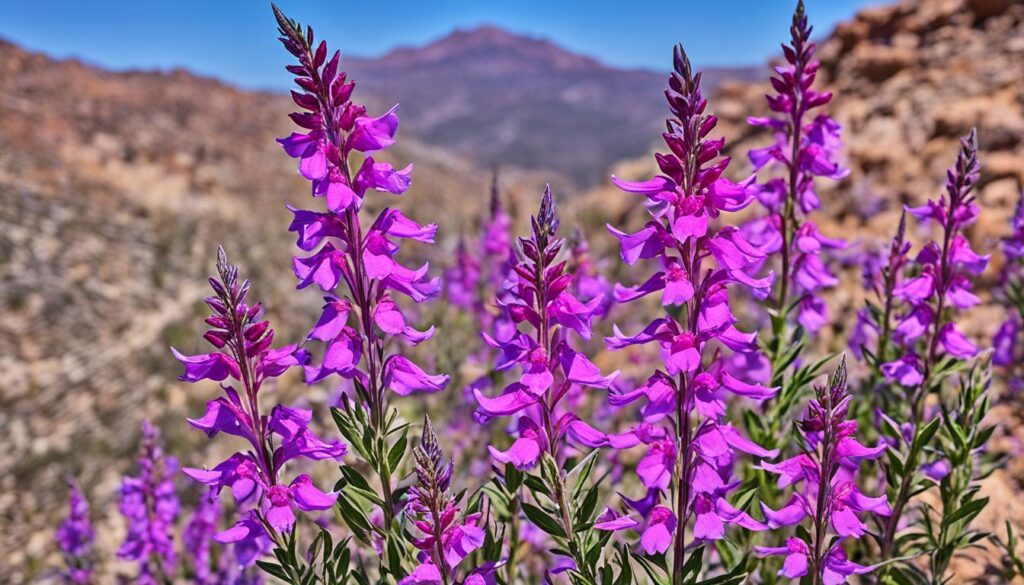
I’ve seen how Penstemon draws bees, butterflies, and hummingbirds. These drought-tolerant flowers are a hit with pollinators, offering nectar all season8. They love full sun and well-drained soil, perfect for gardeners wanting to save water8.
Creating a Hummingbird and Butterfly Haven with Penstemon
Penstemon is a must for gardens that attract pollinators. With different types of Penstemon, you get blooms from spring to fall. This helps pollinators get the nutrients they need89. Plus, hummingbirds love the tubular flowers, which fit their long beaks perfectly.
These plants are also great for sustainable gardens. They’re tough and can handle drought, making them ideal for low-care gardens. Each Penstemon planted helps create a greener, more sustainable space.
Lavender’s Soothing Presence in the Perennial Landscape
Adding Lavender to a garden brings beauty and peace. It’s known for calming effects and its lovely look. As a key Mediterranean Herb, it attracts gardeners with its many uses, from cooking to decoration.
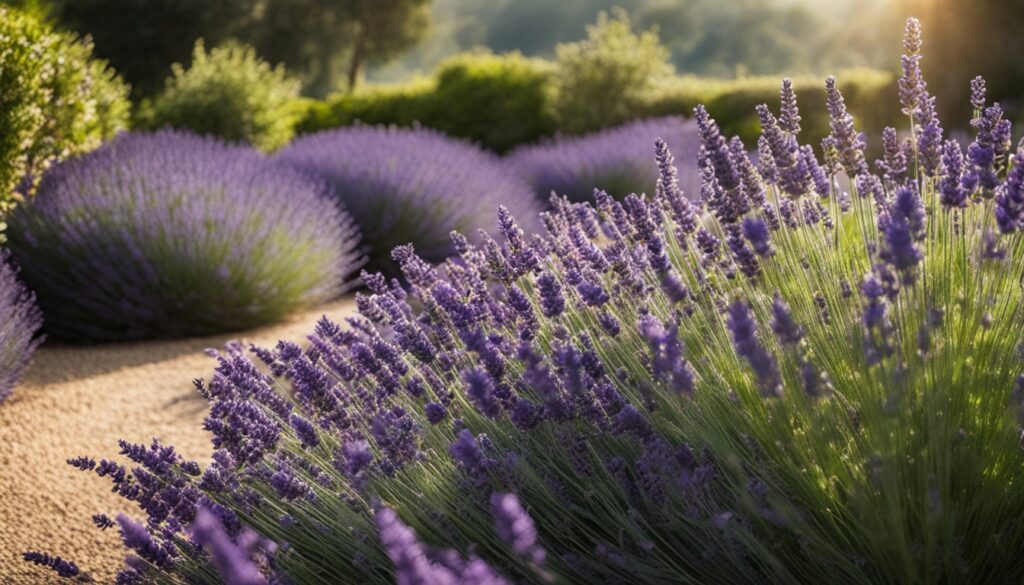
Lavender in gardens does more than make them look nice. It uses Lavender’s history and needs for a garden that’s full of life. Coming from the Mediterranean, Lavender has grown well in sunny, dry places for thousands of years10.
| Lavender Variety | Characteristics | Optimal Growing Conditions |
|---|---|---|
| English Lavender (Lavandula angustifolia) | Sweet fragrance, ideal for culinary use and oil production | Full sun, well-draining soil, minimal watering10 |
| Spanish Lavender (Lavandula stoechas) | Pineapple-shaped blooms, strong scent | Full sun, well-drained sandy soil, infrequent deep watering11 |
| Lavandin (Lavandula x intermedia) | Long stems, high oil content, used for sachets and crafts | Full sun, loamy soil, pH 6.5-7.5, prune annually11 |
| French Lavender (Lavandula dentata) | Finely toothed leaves, subtle fragrance | Full sun, alkaline soil, protected from cold10 |
When growing Lavender, knowing how to care for it is key. Pruning after it blooms helps it grow fuller and live longer. It also needs at least 6 hours of sunlight a day and likes its soil dry once it’s established1011.
Adding this Mediterranean herb to a garden does more than look and smell nice. It creates a Relaxing Garden Setting that invites people to stay and enjoy the lavender-scented air. By giving it the sun and right water, gardeners can keep this lovely plant in their gardens for years.
Coral Bells: A Symphony of Colorful Foliage
I’ve always loved the vibrant colors of Heuchera, also known as Coral Bells. These perennials come in a wide range of colors like deep purples, fiery reds, and refreshing lime greens. They’re perfect for making a garden colorful1213.
Their delicate flowers attract hummingbirds, adding life to the garden12. Coral Bells are also easy to care for and can grow in both sun and shade. This makes them a great choice for any garden spot1213.
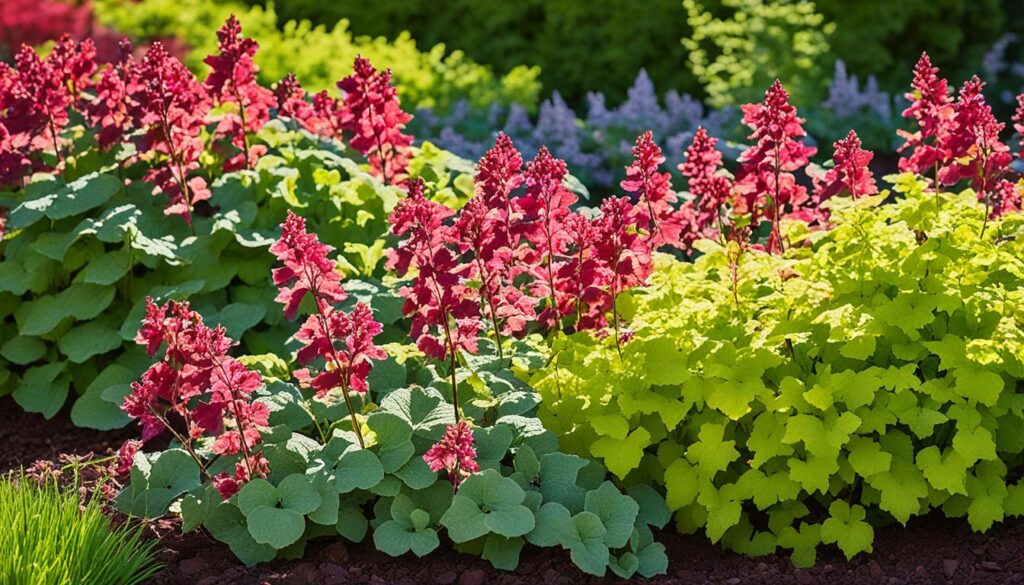
Coral Bells bloom for months, keeping your garden colorful and interesting. They can handle drought and keep your garden looking great in different weather12.
Hummingbird Favorites: The Delicate Flower Spikes of Coral Bells
Coral Bells are more than just pretty. Their flowers are full of nectar, attracting hummingbirds, bees, and butterflies. This helps support local wildlife12.
Adding Coral Bells to your garden means more color and life. It’s a way to support local wildlife with little effort. You can mix and match them to create beautiful contrasts or harmonious blends in your garden13.
Dahlias: Ephemeral Beauty in the Perennial Garden
I’ve always been drawn to dahlias for their bright colors and unique sizes. They stand out in any garden. They’re not just pretty; they’re also great for adding beauty to indoor spaces as cut flowers.
There are over fifty thousand types of dahlias14. This means every gardener can find a favorite. From the huge Café Au Lait to the tall White Perfection Dahlia, they all make a big impact.
In my garden, dahlias add color from summer to fall. Some even bloom in spring when kept in pots15. The sizes vary a lot, with some dahlias reaching over 100 cm tall15. This makes them a standout feature in my garden.
Dahlias are not just beautiful; they’re also practical. They last a long time as cut flowers. This makes them perfect for arrangements that I like to refresh throughout the week.
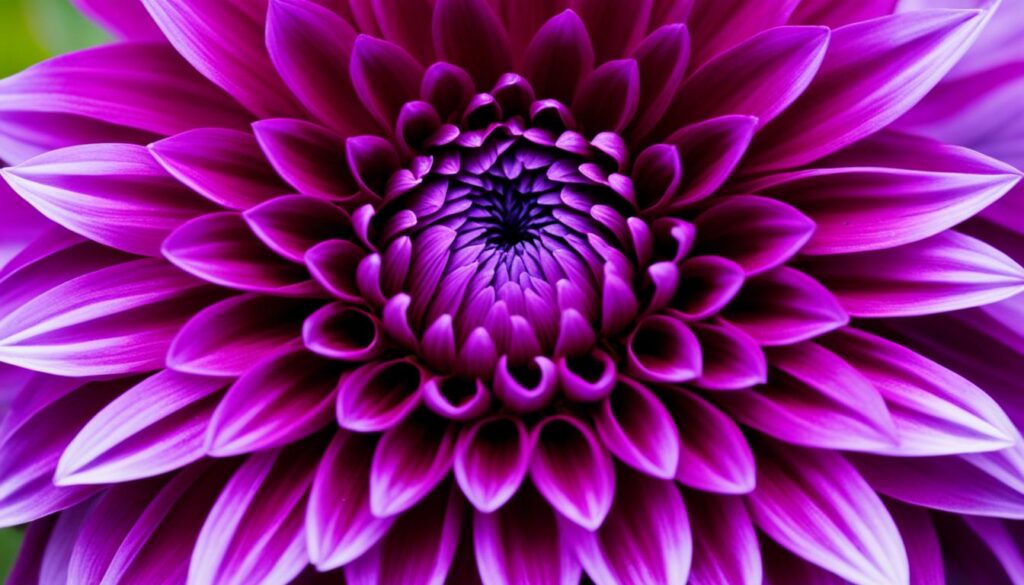
Even though dahlias are beautiful and useful, they need some care in cold areas. You have to lift and store the tubers during winter before replanting in spring. This ensures they come back every year to brighten up the garden.
With dahlias, every season is a chance to enjoy gardening. They’re easy to grow and look great in pots or in the ground. Dahlias add elegance and life to any garden space.
Balloon Flower: A Whimsical Touch to the Perennial Mix
Balloon flowers, or Platycodon grandiflorus, add a magical touch to sunny gardens. Their unique, balloon-like buds open into beautiful star-shaped flowers. These perennials are loved for their beauty and easy care. They rarely get pests16.
As a gardener, I love the look and practical benefits of balloon flowers. They have a big tap root, which makes them hard to move but strong in tough weather17.
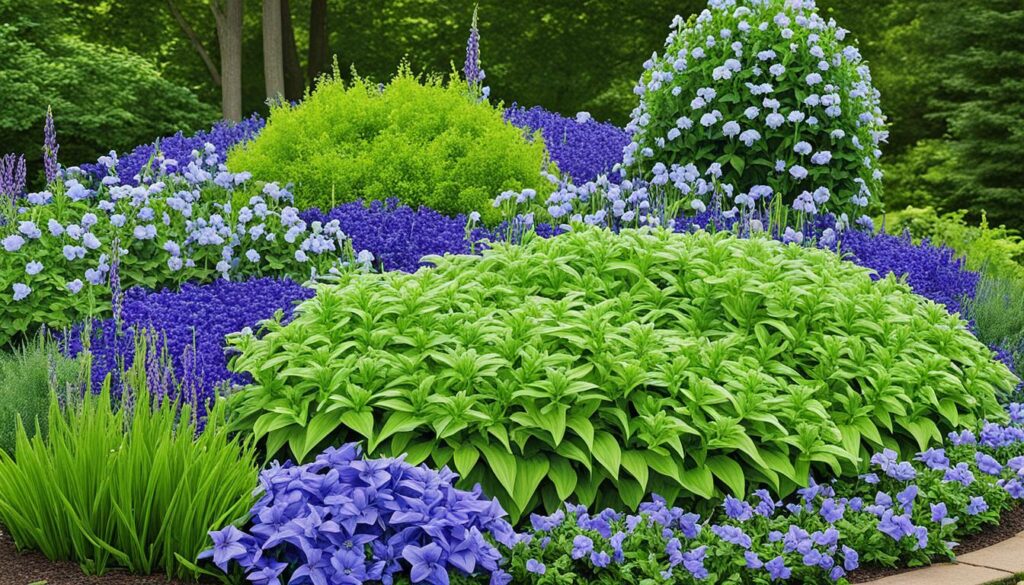
| Variety | Height | Width | Zones |
|---|---|---|---|
| Platycodon grandiflorus ‘Astra Blue’ | 8 inches | 8 inches | 4-9 |
| Platycodon grandiflorus ‘Hakone Blue’ | 24 inches | 18 inches | 4-8 |
| Platycodon grandiflorus ‘Sentimental Blue’ | 12 inches | 18 inches | 4-9 |
Balloon flowers do best in well-draining soil and full to partial sun17. They come back every summer, adding beauty to your garden. They’re easy to care for, making them perfect for all gardeners1716.
These flowers work well with many shrubs and attract pollinators. They’re great for vegetable and flower gardens, and fun to watch butterflies and bees visit17.
When adding balloon flowers to your garden, consider their needs and how they fit with other plants. Their playful look adds whimsy and charm, making them a favorite among gardeners17.
Japanese Anemone: The Graceful Autumn Dancer
Japanese Anemone, also known as Windflower, brings the beauty of Fall Blooming Perennials to life. It thrives in a wide range of environments, from Plant Hardiness Zones 4 to 818. These plants extend the garden’s beauty into late fall, offering flowers that are 2 to 4 inches wide and grow up to 4 feet tall19.
The Japanese Anemone is known for its toughness. It stands strong against insects, diseases, deer, and rabbits18. This makes sure their soft pink, white, and rose flowers stay beautiful all season. With over 120 species, Windflowers add a variety of colors and shapes to any garden18.
Japanese Anemone adds beauty to gardens and contrasts well with other plants. It spreads naturally, filling spaces with its grace18. But, in loose soil, it might spread too much. Gardeners should keep an eye on it and divide it in spring if needed19.
- Height: Typically grows between 2 to 5 feet tall18.
- Blooming Period: Late summer to fall, providing one of the longest blooming periods in the garden18.
- Preferred Conditions: Adapts to most growing conditions; thrives best in full sun to partial shade19.
- Propagation: Can be propagated by dividing mature plants, taking root cuttings, or from seeds18.
For those looking to add beauty to their garden, Japanese Anemone is a great choice. These resilient flowers add an elegant touch to Fall Blooming Perennials. As they sway in the fall breeze, they beautifully close the gardening year, until spring arrives.
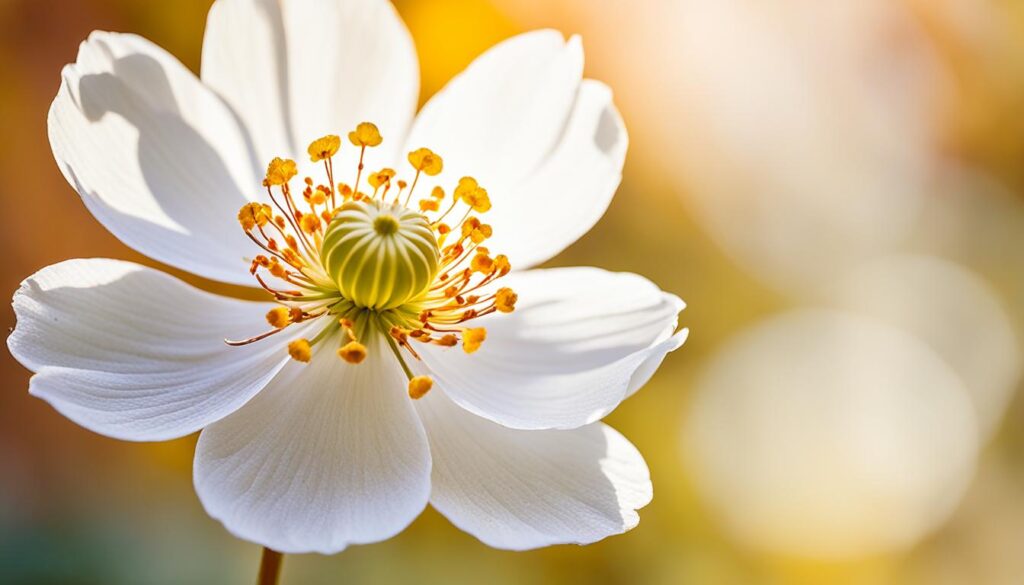
Cranesbill: The Hardy Geranium of the Perennial World
Cranesbill is a top choice among perennial geraniums for its toughness and beauty. These plants brighten gardens with their long-lasting flowers20. They also do well in many places, from full sun to light shade2021. Plus, they can handle poor soil and are very cold hardy.
What makes Cranesbill stand out is its two main benefits: beautiful flowers and leaves that rabbits don’t like20. The leaves have a spicy scent that keeps rabbits away. This makes Cranesbill perfect for gardens with rabbit problems. It’s a great choice for gardeners who want easy-care plants that keep blooming.
Did you know? Cranesbill geraniums like ‘Geranium Rozanne’ have bright violet-blue flowers that pop against the green foliage22.
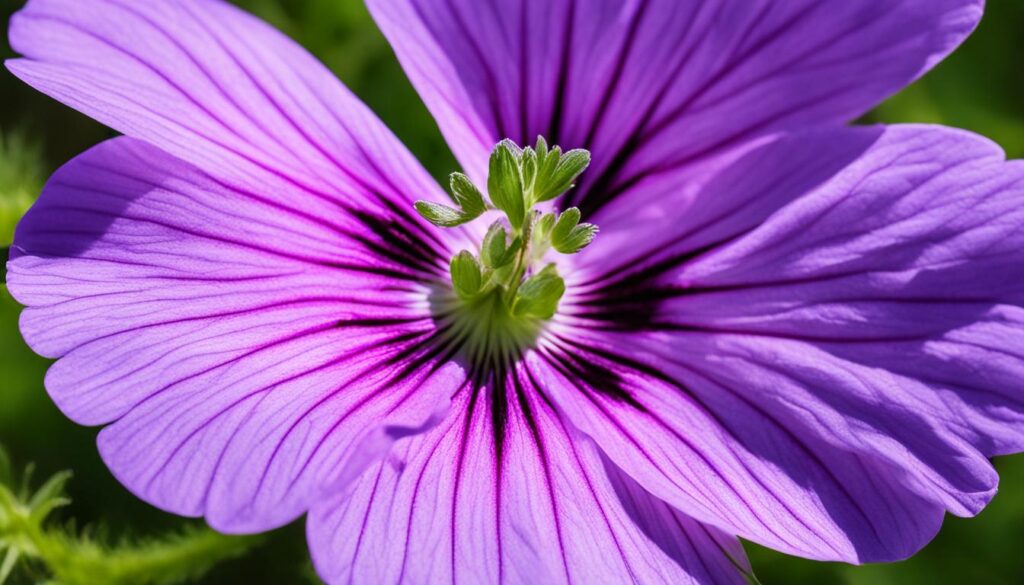
- Long flowering period, extending until the first frosts20
- Ability to grow in tough spots, even in paving cracks, showcasing their toughness20
- Rabbit-resistant plants, offering an added advantage for gardeners20
There are nearly 2,000 types of Cranesbills, each with its own charm22. They come in various sizes and colors, from soft whites to deep purples22.
| Species | Height | Ideal Conditions | Flower Color |
|---|---|---|---|
| Geranium ‘Rozanne’ | 20 inches | Full Sun to Partial Shade | Violet-Blue |
| Geranium ‘Ballerina’ | 4-8 inches | Full Sun | Pink |
| Geranium ‘Havana Blues’ | 14-16 inches | Full Sun to Partial Shade | Blue-Purple |
| Geranium ‘Mavis Simpson’ | 8 inches | Full Sun | Pink |
Choosing Cranesbill for your garden means picking a plant that looks great and faces challenges well. It’s perfect for gardeners who want beauty and practicality in one.
Papaver: Bold Blooms with Delicate Petals
Papaver, or Oriental Poppies, stand out in gardens with their bold colors. They are perfect for Butterfly Gardens, adding life with their delicate petals against greenery.
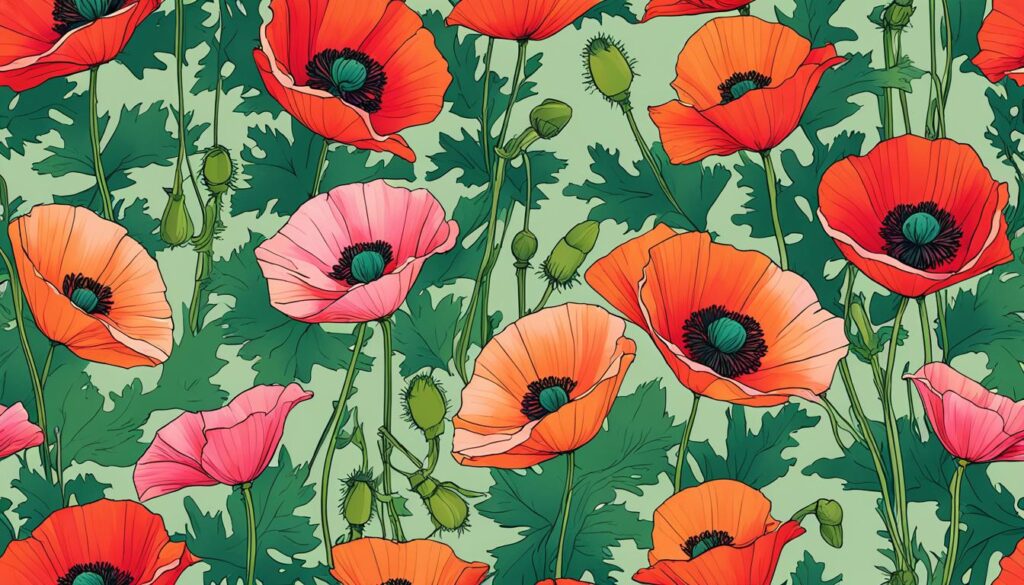
Papaver attracts butterflies and adds beauty to gardens. With Papaver orientale and Papaver atlanticum, you can enjoy colors from bright oranges to soft pastels. This makes your garden lively23.
Attracting Butterflies: The Irresistible Charm of Papaver
Papaver helps pollinators and makes gardens healthier. Oriental Poppies are great for this. Adding these plants makes your garden beautiful and helps local wildlife.
Let’s explore some Papaver species that gardeners love:
| Species | Seed Quantity & Package Size | Price | Plant Height | USDA Zones |
|---|---|---|---|---|
| Jewish Brass (Papaver Somniferum) | 1,000 seeds, 600mg | $3.95 | 24-36 inches | 3-9 |
| Double Mix (Papaver Somniferum) | 750 seeds, 600mg | $3.95 | 30-32 inches | Attracts pollinators |
| Bridal Silk (Papaver Rhoeas) | 500 seeds | $9.95 | 28 inches | 3-10 |
| Beauty of Livermere (Papaver Orientale) | 225 seeds, 30mg | $4.95 | 24-36 inches | Cooler climates |
| Pepperbox Poppy (Papaver Somniferum) | 1,000 seeds, 580g | $3.95 | 24-36 inches | Rapid growth |
Adding Poppies to your garden brings vibrant colors and supports wildlife24. You’re not just planting flowers; you’re creating a home for nature.
Papaver’s beauty attracts everyone to your garden. These flowers add life, color, and energy. They turn any space into a living artwork.
Lungwort: The Spotted Wonder of Shade Gardens
Welcome to the magical world of Lungwort, also known as Pulmonaria. This shade flower is a top pick for garden lovers. Its leaves have silver spots and bloom in purple-pink in spring. It’s perfect for shady spots in gardens across Europe and Asia.
The Pulmonaria family has about 16 types, but only a few are grown often. Pulmonaria ‘Margaret’ and Pulmonaria ‘Blaues Meer’ are favorites, growing in Hardiness Zones 4-7 and 3-7a25. They show why Pulmonaria is loved by gardeners.
Lungwort grows 1 to 1.5 feet tall and loves deep shade26. It can also grow in partial shade. It’s great for planting under tall shrubs or trees, adding depth to your garden. You can find varieties like Pulmonaria x ‘Apple Frost’ and Pulmonaria Longifolia ‘Excalibur’ easily.
When planting Lungwort, space them 12 to 18 inches apart for growth26. This helps with air flow and prevents overcrowding. It’s best to divide them in spring or fall to help them settle in.
Lungwort is more than just pretty; it’s a sign of clean, old forests. It likes moist, shady places and warns us about pollution27. It helps insects and birds by offering shelter and food27.
Adding Lungwort to your garden makes it more beautiful and helps the environment. It supports wildlife and rare lichens. This makes your garden a place of beauty and nature.
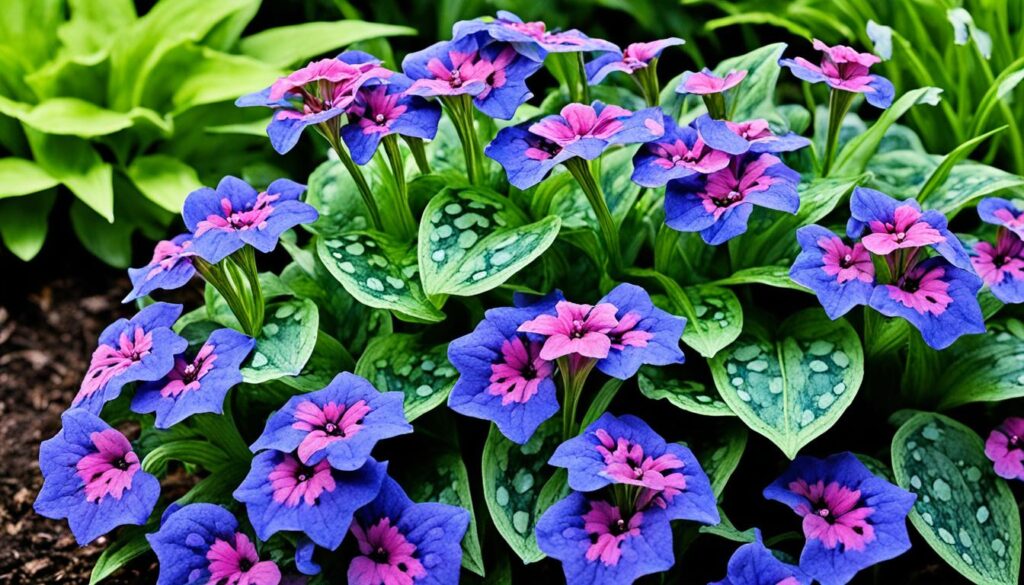
Adding these Pulmonaria species to your shade garden makes it more stunning. It creates a peaceful, magical feel. By doing this, we help our ecosystem and make our gardens thrive in quiet spots.
Garden Flowers: Salvia’s Vibrant Display
As I walk through my garden, Salvia always catches my eye with its bright flowers and variety. It’s one of the heat tolerant flowers that loves the sun. Salvia, a top choice among vibrant perennials, brings beauty and strength to any garden.
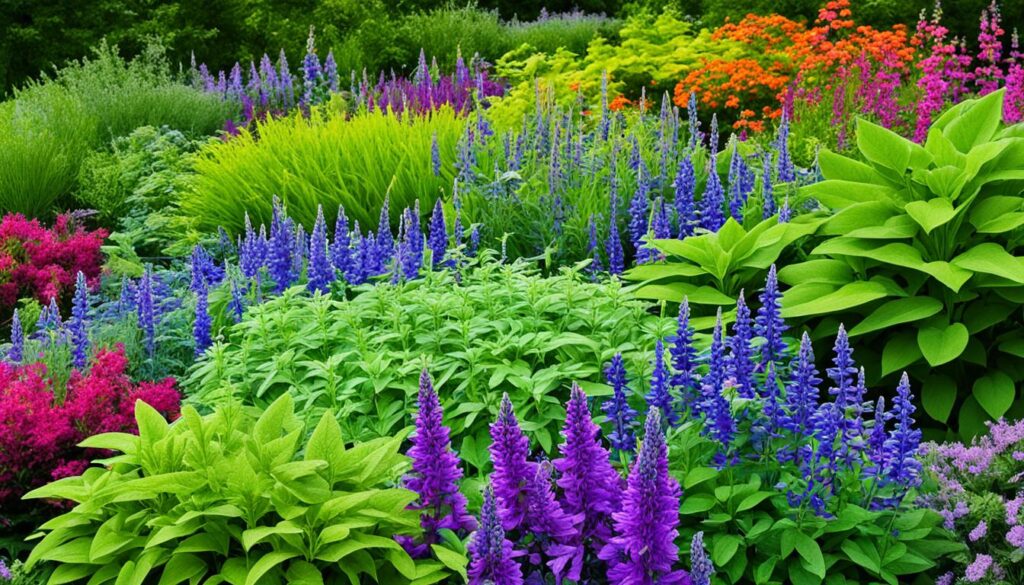
The Blue salvia (Salvia farinacea) can grow up to 3 feet tall, adding height and beauty to the garden28. The ‘Black and Blue’ Salvia (Salvia guaranitica ‘Black and Blue’) can reach 5 feet, creating a stunning backdrop for other plants28. These plants are perfect for adding color and height to your garden.
The Magnetic Appeal of Salvia to Pollinators
Salvia is a big hit with bees and hummingbirds, drawing them in with its tubular flowers. The garden becomes a feast for these pollinators, thanks to Salvia. This helps with pollination and keeps our gardens looking great.
Unfazed by the Heat: Salvia’s Drought Resilience
‘Victoria Blue’ Salvia (Salvia farinacea ‘Victoria Blue’) is great for dry gardens, growing up to 2 feet tall and blooming with blue flowers28. ‘Pineapple Sage’ (Salvia elegans ‘Pineapple’) can reach 4 feet and has a sweet pineapple scent28.
As fall comes, Salvias like Salvia mexicana ‘Limelight’ start to bloom, adding color from September to January29. Salvia greggii ‘Smokin’ Lavender’ blooms twice a year, keeping our gardens bright even in the fall29.
Salvia stands out for its beauty, attracting pollinators, and handling the heat well. It comes in various sizes and colors, making it a key part of any garden. Adding these heat tolerant flowers ensures your garden looks great all year, even in tough conditions.
Conclusion
In the world of Perennial Gardening, we’ve seen a wide range of plants. From the tough Lenten rose to the lively salvia, each adds its own special touch to our gardens. These plants let us show off our unique style with their varied shapes, sizes, and colors30.
I love these lasting flowers for more than just how they look. Gardening is good for our health, lowering blood pressure and cutting down on health risks. It creates a peaceful place for both us and nature30. By growing Pollinator-Friendly Plants like marigolds and sunflowers, we help our gardens look great and support important pollinators3031.
When we work in the garden, we’re not just having fun. We’re also making a difference. Our gardens show the beauty of nature’s cycles and wonders. By planting these flowers, we’re taking care of our planet and making the world more beautiful and happy for everyone3031. Let’s keep gardening, enjoying the many rewards that come with it.
FAQ
What are the benefits of having green perennials in my garden?
How does the Lenten Rose adapt to winter conditions?
What makes peonies a great addition to perennial gardens?
Why are penstemon plants beneficial for pollinators?
Can lavender thrive in all types of gardens?
What unique qualities do coral bells bring to a garden?
Are dahlias easy to care for?
What makes balloon flowers a standout in the garden?
How do Japanese anemones enhance the autumn garden?
Is cranesbill a good choice for difficult garden spots?
Why should I consider adding papaver to my garden?
What is lungwort’s appeal in shaded areas?
How do salvias contribute to a vibrant perennial garden?
Can perennial gardening benefit local wildlife?
Source Links
- 20 of the best perennials
- The 20 Most Beautiful Perennial Flowers to Plant in Your Garden
- Embracing Winter: Adding Beauty to Your Frosty Garden
- How To Grow And Care For Lenten Roses And Other Hellebore Varieties
- 9 Advantages of Having a Hellebore 🦋
- How to Grow Peonies
- Peonies: The 9 Must-Have Varieties for a Garden Makeover
- 10 Best Perennials for Pollinators
- Plant a Pollinator Paradise | Piedmont Master Gardeners
- Lavender Garden Guide
- 5 Lavender Landscaping Hacks
- Symbolism and Benefits of the Coral Bells
- Coral Bells / Heuchera
- Ephemeral Spring Beauties
- BalsamWreaths.com Fresh Balsam Christmas Trees, Wreaths, and Garlands
- Balloon Flowers Are Great in Arrangements and Fun to Pop!
- Balloon Flower Companion Plants | Plant Addicts
- This month’s feature plant is the Japanese Anemone, Windflower genus Anemone hupehensis. — Yoga Judith
- Plant Focus: Japanese anemone – Michigan Gardener
- How to grow hardy geraniums
- Rob’s plants – the hardy geraniums
- Best hardy geranium varieties – 15 classic cranesbills for every garden
- Poppies
- Our Favorite Poppy Flower Seed Page
- Pulmonaria – The World of Lungworts
- Lungwort Plant – Easy Shade Gardening – Plants and Ideas
- Lungwort, party of three
- 31 Salvia Plants to Bring Color and Fragrance to Your Garden
- Four Seasons of Salvias – Harmony in the Garden
- The Benefits of Cultivating a Flower Garden – Island Gardens
- Flowers Essay for Students and Children | 500 Words Essay
